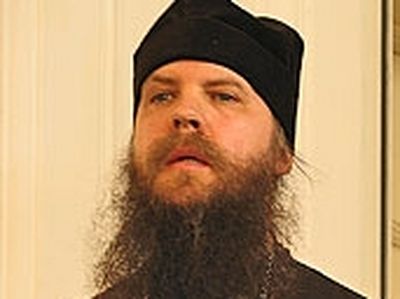This paper of Vincent Rossi comes from his time as a student at Oxford under the tutelage of Metropolitan Kallistos Ware. He has a deep passion for Orthodox cosmology, as well as its environmental implications. He has served as the U.S. Director of the U.K.-based Religious Education and Environment Programme and has authored two books and nearly a hundred articles on spirituality, theology, and the environment. He founded and served for twelve years as the editor of the journal Epiphany and has served as the Director of Education for the American Exarchate of the Jerusalem Patriarchate.
At one time he was a Roman Catholic pre-seminarian student and worked as a Chinese specialist for the Intelligence Section of the U.S. Navy, and was instrumental in guiding a group of hundreds into the Orthodox faith in the 1980’s, which led to his studying under Metropolitan Kallistos. Vincent currently resides at St. Silouan the Athonite Monastery (ROCOR) in Sonora, CA.
* * *
 St. Maximos the Confessor
St. Maximos the Confessor
However, the evidence in The Mystagogia, and consistently throughout the entire Maximian corpus as well, would seem to point overwhelmingly to the opposite conclusion. The theology of St. Maximos does not support a cosmology along evolutionary lines; indeed, it positively militates against such a view. It is interesting to note that Maximos’ thought is particularly refractory to evolution at precisely the points mentioned by Nellas and Thunberg as possibly favoring or at least Christianizing and completing the contemporary world-conception of evolution: the relation of matter, form and archetype, the logos doctrine and the evaluation of movement as a creative force. Both authors are profound students of the thought of St. Maximos, so it would seem that any misjudgment lies more in a rather vague conception of evolution as a ”biological” or ”scientific” fact than in any misunderstanding of the Confessor’s thought. Thunberg’s discussion of the logos doctrine of Maximos in his Microcosm and Mediator[3] and P. Sherwood’s complementary analysis in the Earlier Ambigua[4] are the two best treatments of the topic in English, and my own analysis relies on both.
The relevance of an ancient author to contemporary problems depends primarily on how much intellectual light and instruction may be educed from the confrontation between an ancient perspective and a modern conception. On that basis, disagreement might be equally as illuminating as agreement, if not more so, particularly because every age constructs its own world-view, in which certain elements become so ”blindingly” clear as to be unquestioned assumptions. It is often these assumptions which a later age will judge as the characteristic “blind spots” of that time from its own more congenial, more contemporary point of view. But we do not have to wait for the future to discern the blind spots in the present. The past may also help us awaken to new or forgotten perspectives, especially if we are able to respect the achievements of the past that may have perennial significance. Such an achievement was Maximos’. Living in the thought-world of St. Maximos requires not only critical distance but also a kind of ”metanoia,” a transformation of perspective akin to a conversion of mind. It is not for nothing that every aspect of Maximos’ speculative thought is grounded in the ascetic practice of a monastic way of life and pillared by the eschatological vision of a contemplative spiritual master.
The assertion that St. Maximos could not have been an evolutionist himself is a fact of history, since the concept of evolution as we know it today is a peculiarly modern idea, although there are certainly antecedents enough before the publication of Origin of Species in 1859, stretching back through the naturalistic philosophers of classical times possibly as far as Anaximander of Miletus (550 BC).[5] The assertion that the theology of St. Maximos cannot support an evolutionary interpretation is not immediately self-evident. We must discover and closely compare the points where the philosophy that underlies the notion of evolution meets the philosophical framework of Maximos’ theology.
It is important to bear in mind that it is not the intention of this analysis to compare ”science” with ”theology” nor the work of a scientist (Darwin) with that of a theologian (Maximos). It is rather an effort to grasp what the notion of evolution presupposes as a philosophical basis in order to compare it with the philosophical presuppositions of Maximos, for only in this way will a comparison with the thought of Maximos be meaningful. The doctrine of evolution as it is believed in even by professional scientists is shot through with generally unrecognized philosophical assumptions which elevate it in the contemporary mind to an unassailable mythology.
Therefore, it is important to note that despite the ubiquity of the notion of evolution in education, science and social scientific and even theological circles today, many reputable scientists themselves recognize that none of the observable facts and processes of the universe are as such evolutionary, and this includes the ”geologic column” and the ”fossil record.”[6] Facts and processes exist in themselves and their existence and development must then be explained.[7] Evolutionism is such an explanation. Hence, contrary to the confident assertions of countless secondary school biology teachers and science writers, evolution is not a ”fact” of science but rather an attempt by scientists and others to explain the facts of nature as they (the facts) actually exist and are observed. (We will reluctantly leave out of this discussion, as liable to lead us too far afield, what a fact actually is and how exactly a fact or phenomenon is actually experienced or known.)
Today both antievolutionists (creationists) and responsible scientists agree that the best way to describe the concept of evolution is as a scientific model. A model is a conceptual framework which may be used to correlate and predict data, such as the character of the fossil record or the laws of thermodynamics. A model is thus an orderly system of thought containing one or more axioms, principles or basic assumptions. Alternative models may exist which then may be compared as to their respective capacities to correlate and predict the data in question. Evolutionism, like creationism, is a model of origins. Sometimes referred to as the “general theory of evolution,” it purports to explain the origin of everything form the macrocosmic universe to microorganisms to man in accordance with a naturalistic mechanistic, mathematical conception of the universe. Creationism, as a model of origins, has a seemingly opposite set of assumptions. It bears repeating that no model is in itself “scientific,” that is, confirmable by observation and repeatability and falsifiability.[8] A model cannot be falsified because it can be made to fit any and every conceivable observation or fact. This is as true of the evolution model as of the creation model.[9] Therefore, neither can be “proved.” Each can be compared with the other as models to determine which one correlates and predicts the data more effectively, and which one fits the facts with the fewest modifications or secondary assumptions. The axiomatic nature of the model must be assumed. The reason for accepting one model of origins over the other then, are philosophical or theological, rather than scientific, strictly so-called. One is an evolutionist or creationist by ”faith” rather than by ”science.”
Classical Darwinism consists of two aspects: a materialistic conception of origins (evolution) and a mechanism for change (the interplay of chance and natural selection). The mechanism of selection depends on three premises: 1) variation—that organisms vary; 2) inherited characteristics—that these variations are somehow inherited; and 3) survival of the fittest—that all organisms were involved in a struggle for survival. The second premise was always the weak spot of classical Darwinism because the mechanism of inheritance was imperfectly understood, and the third premise has been called into question in recent evolutionary theorizing. With the discovery of Mendelian genetics, classical Darwinism was gradually abandoned or reborn as Neo-Darwinism, which depends upon favorable mutations plus selection to explain origins. Neo-Darwinism has had a run of sixty years or so, until in the late Sixties and early Seventies, the discoveries of molecular biology and of the harmful effects of “genetic burden,” coupled with the failure of paleontology to discover convincing transitional forms, has led to an abandonment by many evolutionists of “gradualism” and natural selection in favor of “hopeful monsters,”[10] ”punctuated equilibrium”[11] and ”stochastic” evolution.[12] It remains true that some form of selection is still considered the most credible aspect of evolutionary thinking. Even creationists, although they balk at the term ”microevolution,” accept the reality of some form of selection in the relationship of organism to environment (seen as variation within “kinds”).
In order to forestall a possible objection at this point, let us pause to consider whether there is a third model of origins to be taken into account of in our survey, namely ”theistic evolution.” Theistic evolution in its various forms is widespread among Christian theologians who are convinced of the ”fact” of evolution and who therefore must struggle to reconcile the evolutionary world-picture with Christian theology. Attempts to incorporate evolution into a theology of creation are known by various names, including ”emerging evolution,” “creative evolution,” “nomogenesis” (evolution according to a fixed law), ”orthogenesis” (goal directed evolution), ”progressive creationism,” “threshold evolution” and ”Biblical evolution.” Despite the difference of names, all are similar to understand the universe in evolutionary terms. In the simplest form, theistic evolution represents the Lord God Jehovah as merely using the process of evolution to accomplish his creative purposes. The difficulties of harmonizing this view with the account of creation according to Scripture, resulting in such exegetical oddities as the "gap theory” and the ”day-age theory” need not be considered here.
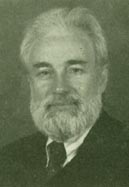 Vincent Rossi
Vincent Rossi
Is theistic evolution, then, sufficiently distinct from both scientistic evolutionism and creationism to be considered a third model of origins? After allowing for every possible gradation between the two basic theories in question, the answer must be no. The theistic evolutionary conceptual framework is not sufficiently distinct from scientistic evolutionism to be classed as a third model. Theistic evolutionists tend to be uncritical and subservient towards evolutionist science, focusing their critical energies more against “fundamentalist” positions than toward revealing the philosophical presuppositions of the evolutionary paradigm. Even a theologian as astute and perceptive as Moltmann is unable or unwilling to recognize a contradiction in principle between creation and evolution.[13]
In summary, then, the evolution model assumes a self-existing, self-contained universe whose innate laws are naturalistic, non-purposive, upwardly directional (antientropic), irreversible, universal and continuing. By contrast the creation model among evangelical Christians and a growing number of scientists a diametrically opposed world view, it seems: a supernaturally created universe, giving evidence of being externally directed, purposive, universal downwardly directional (entropic), conservative and completed.[14]
Our question is: can the speculations of St. Maximos be applied to the doctrine of evolution? Or is the Confessor a seventh century creationist as contemporary Christians would understand the term? The evidence and structure of Maximos’ though, it seems to me, forbids any attempt to link him in a positive way with the doctrine of evolution. With regard to creationism, St. Maximos was a confessing Christian, witnessing the faith to the point of martyrdom, a monk and spiritual master. It would be astonishing if his cosmological doctrine did not show some affinity with contemporary Christian creationism. Nevertheless, we should not be too quick to assume a deep affinity between the cosmology of Maximos and the world-picture of contemporary creationists. The nature of his cosmological vision—his cosmotheanthropic paradigm, if you will—is rooted in a spiritual vision of the universe and metaphysical presuppositions about space, time and matter utterly incompatible with the paradigm or world-view of modern science. To a large extent, contemporary creationists, scientists or theologians, seek to work within the modern scientific paradigm. To that same extent, then, is the cosmology of St. Maximos as incompatible with creationism as with evolutionism, since Maximos’ thought is based on fundamentally incompatible metaphysical principles.
To repeat, for the sake of clarity, the gist of our thesis so far: to seek affinity in the thought of St. Maximos with contemporary natural science, one must compare the modern scientific paradigm and the cosmology that follows therefrom with the metaphysical and cosmological thought of St. Maximos. The doctrine of evolution is an indispensable element of the paradigm of modern science. The character of evolution is not a “fact” of biology but is an axiom of the scientific paradigm. Thus, we may formulate the scientific paradigm in terms of a few basic and interdependent axioms, which constitute the philosophic presuppositions underlying the evolutionary cosmology: 1) everything that happens is the effect of what has already happened; 2) everything that happens is basically matter in motion—the interconvertability of matter and energy; 3) the physical basis of all motion in the cosmos is randomness; 4) everything evolves (from simple to complex); 5) space-time is the only reality; 6) the only true knowledge is sense data supported by mathematics; 7) the idea of God is an unnecessary hypothesis in the pursuit of reliable knowledge and truth.
Contemporary creationists will replace axiom #4—“everything evolves”—with “everything is created by God ex nihilo,” and expand axiom #5 to include another reality called “spiritual” pertaining to God; but the substitution of creation ex nihilo for evolution and belief in the existence of “spiritual” reality do not fundamentally affect the world image of contemporary creationists, which remains largely similar with that of the scientific paradigm.
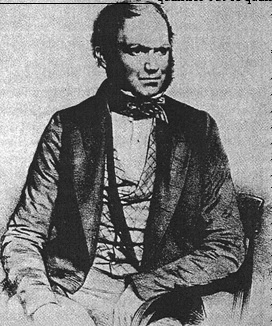 Darwin as a young man
Darwin as a young man
It is the view of Lars Thunberg that there seems to be no single place in the writings of St. Maximos where the entirety of the Confessor’s cosmological doctrine is to be found. Thunberg has discovered at least eight elements of St. Maximos’ cosmology in the first section of Char. 4.[15] P. Sherwood identifies chapters 21-33 of Char. 3 as a distinct group that describes the relation of God and his creatures as a background to the spiritual doctrine of the Centuries on Charity.[16] I believe a third area of profound cosmological significance, where the entirety of Maximos’ cosmological vision may be discerned in summary form, may be found in the first seven and final two chapters of the Mystagogia.
However, a listing of cosmological elements does not a cosmology make. Nor do detailed word studies of key concepts such as substance (ousia), hypostasis (hupostasis), difference (diaphora) , distance (diastasis) , separation (diastema) , division (diairesis), motion (kinesis), order (taxis), position (thesis) and quality (poiotes) necessarily reveal the image of the world that motivates Maximos’ thought. Taking the eight cosmological elements culled by Thunberg from Char. 4. for example—1) creatio ex nihilo, 2) creation because of God’s will, 3) creation by the Word, 4) creation because of God’s benevolence, 5) creation because of God’s prudence, 6) creation as Divine condescension introducing an element of motion, 7) every creature composed of substance and accident, and 8) creation not of qualities but of qualified substances—it is easy to see that a contemporary creationist, who accepts the basic assumptions of the scientific paradigm (excepting, of course, evolution) would accept every one of these elements as self-evident from the belief that God created all things, although he would perhaps regard #7 and #8 as rather quaint and outmoded philosophical expressions. Yet by holding to the basic world-picture of the paradigm of modern science, he would be al- most as distant from the cosmological vision of Maximos as would the evolutionary scientist.
A mere belief in God, in other words, or an externalistic theism, does not necessarily change one’s vision. What is needed to penetrate intuitively into the Confessor’s thought is to comprehend imaginally the living constellation of ideas that illuminates his cosmological vision. That is to say, for Maximos, cosmology is, above all, a theological vision. To say vision is to say perspective, point of view, a noetic eye or adequate organ of perception, and, above all, an illuminated image. The eye, noetic or physical, sees synthetically, all at once, uniting in a single act, of perception all the elements of the vision in a single image. It is therefore one thing to isolate for analysis the cosmological elements in Maximos’ writings; it is quite another to reconstruct those separate elements into a coherent world-image; and when we have done so, will what we have reconstructed logically bear any relation to the image that Maximos sees intuitively or noetically?
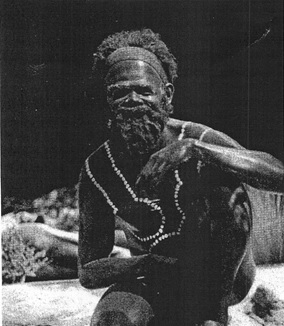 Model of an aborigene
Model of an aborigene
For St. Maximos, the ruling principle of his cosmological vision is the doctrine of the Logos. Scholars have given a great deal of attention to the Logos doctrine of Maximos. Its cosmological dimensions have often been noted.[17] But the full depth and significance of the cosmological dimension of the Confessor’s doctrine of the Logos have hardly been tapped. Maximos sees the Face of Christ shining forth everywhere, in all things, places, persons and events, irradiating and illuminating all, holding the entire meta-macro-microcosmos together in love and drawing all separate things toward unity by the irresistible power of the ontological tenderness of his lifegiving Gaze. To grasp the implications of this Maximian insight into the cosmological significance of the love of Christ for and in all creation is to see immediately that the doctrine of evolution can have no place therein, for its underlying assumptions violate the principle of Logoic love by which and in which all things cohere: in eo, omnia constant (Col.1:17).
In the Logos doctrine of St. Maximos, there are three fundamental ”moments,” corresponding to the three major themes in the Christian redemptive tradition: Creation, Incarnation, Resurrection. But for Maximos, creation, incarnation and resurrection are not separate acts of God, neither by nature nor in time, but are simultaneous aspects of all God’s creative acts. P. Nellas has observed that Maximos seems to be working with an ”alternative conception” of time.[18] This is a highly significant observation. The meaning of time in the thought of Maximos has not been given much attention. The whole tenor of the Confessor’s thought aspires to the contemplation of things from the Godward standpoint. Hence, the notion of time will have a radically different value than that of the earth-bound conceptualizing characteristic of the scientific paradigm. From the Godward perspective of Maximos, simultaneity will predominate over sequentiality, and time will be seen to possess no ”substantiality” at all. Because of this theocentric perspective, we might also observe that Maximos possesses an “alternative conception” of causality. A ”cause” for Maximos is not merely an event prior in time to its effect, as it is in the contemporary zeitgeist; rather a cause is whatever provides a reason (logos) for the existence, development and fulfillment of anything else, without the notion of time entering in at all. Such an understanding of causality is intimately connected to the concept of telos in Maximos. His worldview is profoundly and completely teleological. In Amb. 7, Maximos defines telos as “that for the sake of which all things are, though itself for the sake of nothing.”[19] By contrast, the modern evolutionary paradigm is consciously anti-teleological[20] and time itself is a quasi-absolute metaphysical category.
Thus, in the Logos doctrine of St. Maximos, creation, incarnation and resurrection are indissolubly united. Every act of God is creation through the Logos, incarnational in the Logos and, potentially, resurrection of the Logos (this last, in Maximos, is linked with deification and true gnosis). It is precisely Maximos’ conception of the identity of creation and incarnation in the Logos that makes it impossible to reconcile his doctrine of creation with the concept of evolution. The following analysis of the Logos doctrine and its implications will hopefully make this clear.
A key statement of Maximos indicating the identity in mystery of creation and incarnation in the Logos is found in Amb. 7: “The Logos of God, who is God, will to bring about the mystery of his embodiment always and in all things.”[21] This statement is not, as Thunberg sees it, primarily an assurance of God’s final intention towards creation,[22] although it is that, but is an assurance that creation is from the very beginning and until its end rooted in its core and permeated in its every aspect and dimension by the Presence of the Divine Logos, whose actuality constitutes the actuality of each and every created thing. Implied here, and expressly stated in other contexts, is the Maximian insight that the Logos is the constituting and hence unifying principle of all things, the true Inspiration of all their activity and the source of the aspiration that moves and impels all toward completion, fulfillment, consummation. “It is in him [the Logos] as Creator and Maker of beings that all the principles of things (oi ton onton logoi) both are and subsist at once in an incomprehensible simplicity.”[23]
For Maximos, the insight that “God wills to effect the mystery of His embodiment (ensomatosis)” indissolubly links creation and incarnation. He refers often to a threefold embodiment of the Logos: in creation, in Scripture and in humanity.[24] Alan Riou succinctly sums up Maximos’ teaching on this point:
The incarnation of the Logos is the logoi of created beings at the time of the creation of the world and of the four elements, when the Spirit of God covered the waters; the incarnation of the Logos in the logoi of Scripture and the four Gospels, when the Spirit inspired the “prophets;” the incarnation of the Logos in our flesh, in the man of “our kind,” in the humanity that is ours, realizing the fullness of the four cardinal virtues, when the Spirit covered the Virgin with His shadow.[25]
As is well-known, St. Maximos is inspired by a profound and far reaching vision of unity revealed in creation. But a Thunberg point outs, this vision of unity is based on an equally profound and far-reaching understanding of difference (diaphora). Difference is a general characteristic of the created world. Maximos sees diaphora as constitutive of creation and a positive aspect of God’s intention for the cosmos. Diaphora will never disappear. Unity and difference for Maximos are reciprocally linked. It is the Logos that holds the concepts of unity and difference together in an unconfused way. The appearance of the language of Chalcedon indicates that Maximos is applying the Christological principle of Chalcedon to the cosmos; and it is this Chalcedonian cosmology that is Maximos’ greatest achievement in cosmological understanding. Through this principle the cosmological dimension of Christology may be recovered and the Christological foundation of cosmology may be revealed.
In an aphoristic sentence profound in its simplicity, Maximos teaches the principle of unit in difference: “There is but one[26] world and it is not divided by its parts.” He uses the figure of a circle with straight lines radiating out from a common center and circumscribed at the periphery to show the unifying relationship of the supreme Principle, the Logos, to created things through their inner essences or principles, the logoi:
It is he who encloses in himself all beings by the unique, simple, and infinitely wise power of his goodness. As the center of straight lines that radiate from him he does not allow by his unique, simple, and single cause and power that the principles of beings become disjoined at the periphery but rather he circumscribes their extension in a circle and brings back to himself the distinctive elements of beings which he himself brought into existence. The purpose of this is so that the creations and products of the one God be in no way strangers and enemies to one another y having no reason or center for which they might show each other any friendly or peaceful sentiment or identity, and not run the risk of their being separated from God to dissolve into nonbeing.[27]
In other words, every created thing is different from every other, but this difference is not divisive (diairesis) because what makes each created thing different is its own unique inner essence (logos), and it is precisely that inner essence that is mysteriously one with the divine Logos as image to Archetype. The inner essences of all things are beloved by God and are thus inviolable and destined by the Divine intention woven into their inner beings to be drawn into unity with Him. They were not created to disappear, but to be consummated in their movement toward unity in their supreme Archetype, the Logos, the Essence of essences. As Maximos states earlier in the same chapter:
For God who made and brought into existence all things by his infinite power, contains, gathers and limits them and in his Providence binds both intelligible and sensible begins to himself as cause, beginning and end, all beings which are by nature distant from one another; he makes them converge on each other by the singular force of their relationship to him as origin. Through this force he leads all beings to a common and unconfused identity of movement and existence, no one being originally in revolt against any other or separated from him by a difference of nature or of movement, but all things combine with all others in an unconfused way by the singular indissoluble relation to and protection of the one principle and cause. This reality abolishes and dims all their particular relations considered according to each one’s nature, but not by dissolving or destroying them or putting an end to their existence. Rather it does so by transcending them and revealing them, as the whole reveals its parts or as the whole is revealed in its cause by which the same whole and its parts came into being and appearance, since they have their whole cause surpassing them in splendor.[28]
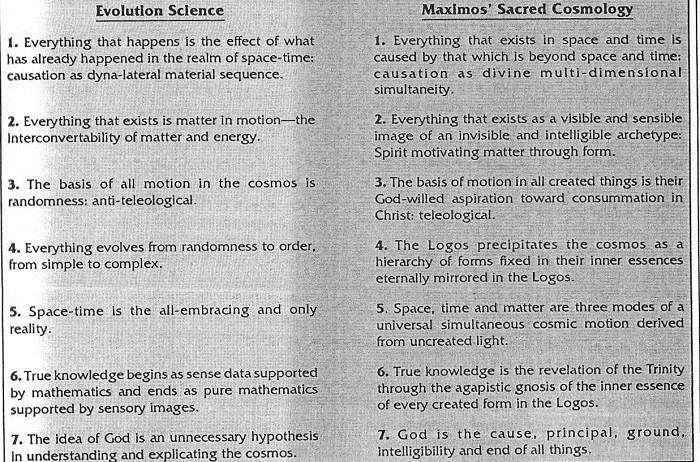
This is a surpassingly concentrated and profound statement. Maximos pours his entire cosmological vision into these few lines. It is impossible here to do complete justice theologically to this passage by unpacking it fully in all its depth and breadth. It will perhaps be sufficient for our purpose to draw attention to a few points relevant to our comparison of Maximos’ cosmological vision with the evolutionary worldview. 1) The creation of all things by God is simultaneously a containing, gathering and limiting of creatures which assures their permanent distinctiveness and their unity in God as cause, beginning and end. 2) The primary difference in creation is between intelligible and sensible beings, but this difference is, through Divine Providence, a bond between God and all things and all things with each other. 3) Every created nature implies distance (diastasis) one from the other, but at the same time each created nature has a corresponding natural movement which is purposed by God to lead to a common and unconfused identity of each thing in its common, single principle and cause: the Logos. 4) The unity in difference and difference in unity of all created things is based on and protected by the relationship of all to the Logos as Origin and End. 5) The relationship of all to God as origin and End manifests as movement, a movement of aspiration that leads to the consummation of each created existence, not by destroying its particularity, but by a transfiguration of its nature in the surpassing splendor of its cause and end, the Logos. All these points add up to a vision of reality utterly incompatible with the evolutionary world-picture, because all created forms and organisms are stabilized and preserved in the love of God through the participation of their inner essences (logoi) in the Divine Logos.
As we have seen, the relationship of the Logos to all created beings through their logoi is the key to Maximos’ cosmology, the ontological basis of unity in difference, and the solution to the perennial problem of the one and the many. The logoi define both the essence (ousia) and the coming into existence of things. The differentiated logoi pre-exist in God and are firmly fixed in Him.[29] These logoi, as the inner essences of created beings, are the differentiated images of the one Logos in creation. Created beings may exist in or out of harmony with their logoi, but when they are in harmony, they will move according to the fixed purpose (prothesis) of God. The one Logos is incarnated in the many logoi and the logoi are transfigured in their movement toward the Logos. To the vision of Christian contemplation (theoria), the one Logos will be seen in the many logoi and the many logoi in the one Logos,[30] yet the Logos retains His superessential character.
The logoi are part of the intelligible world and link that world with its alter image, the sensible world. A beautiful passage in the Mystagogia describes the reciprocal relationship between the two worlds, and shows again the signature of Chalcedon—the hologram of unconfused unity in duality—as the key to both conceiving and perceiving the sacred image of the cosmos:
The entire world of beings produced by God in creation is divided into a spiritual world filled with intelligible and incorporeal essences and into this sensible and bodily world which is ingeniously woven together of many forms and natures ... it encloses the differences of the parts arising from their natural properties by their relationship to what is one and indivisible in itself. Moreover, it shows that both are the same thing with it and alternately with each other in an unconfused way and that the whole of one enters into the whole of the other, and both fill the same whole as parts fill a unity … for the whole spiritual world seems mystically imprinted on the whole sensible world in symbolic forms, for those who are capable of seeing this, and conversely the whole sensible world is spiritually explained in the mind in the principles which it contains. In the spiritual world it is in principles, in the sensible world it is in figures.[31]
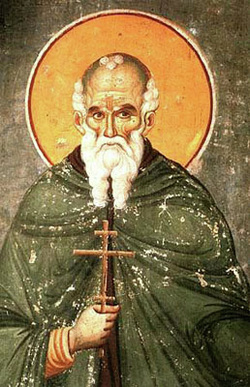 St. Maximos the Confessor
St. Maximos the Confessor
This vision of the world as a sacred order in which the Presence of God is manifest as the inner world, wisdom and harmony in all living forms of plants, animals, mountains and seas, earth and sky, sun, moon and stars, cannot by any means be equated with the evolutionary view of the universe. The worldview of the scientific, evolutionary paradigm apotheosizes force over form and paradoxically seeks intelligibility in exact mathematical description of what is by nature unintelligible—the random, mechanistic interaction of particles and bodies. In chapter 23 of the Mystagogia, Maximos describes the “wise foolishness” of the Greeks in terms which would readily apply to the evolutionist attempt to explain the world without God:
For one should not speak of true contemplation what I call the surface of sensible things, as did the fools whom the Greeks called wise. Among us they would never have been called wise because they could not or would not recognize God from his works. On the basis of this surface appearance of things there has developed a perpetual war of these things with each other to the mutual destruction of all since everything is destroying each other and being destroyed in each other, and the only result is that they are unstable and perish and are never able to meet each other in a tranquil and secure situation.[32]
These passages—and there are many others that could be cited—are sufficient to show the radical incompatibility of Maximos’ cosmological vision and the evolutionary cosmology of the paradigm of modern science. In the first place, the world-image of Maximos clashes decisively with the world-image of evolutionism. The cosmos for Maximos is a sacred reality, that is, its every aspect and dimension is charged with the glory, grandeur, energies and presence of God. In evolutionism, the sacred has no intrinsic place, except as a subjective experience entirely divorced from “objective” reality; the sensible world—the only real world—is sufficient to explain itself. But for Maximos, the universe cannot be explained outside God, not just the origin of the cosmos but also the inner workings of every created thing. Hence, the first axiom of Maximo’s sacred cosmology (in contradistinction to the first axiom of the evolutionary paradigm stated above) might be: everything that exists in space and time is caused by that which is beyond space and time.
The evolutionary view of the cosmos assumes that the ground of objective reality is matter-energy. The vision of Maximos is grounded in the metaphysical hierarchy of being. Axiom #2 of Maximos might read: Everything that exists is a visible and sensible image of an invisible and intelligible Archetype. Since the created world is rooted in the Logos as Origin and End, the sacred cosmology of Maximos would oppose the evolutionary paradigm’s axiom of the random basis of motion and change with the idea of the purposive nature of motion in all created beings as the aspiration implanted by God in each created nature to move toward its consummation in Christ. The world-image of Maximos is radically teleological; that of evolutionism a denial of teleology.
Evolution as transformism of species is denied in the Maximian cosmology by the preexistent logoi fixed in God and coming to existence as qualified substances in the sensible world in harmony with God’s creative intentions. The well-known logos/tropos distinction,[33] which Maximos uses so effectively in his Trinitarian and Christological theology, is radically anti-evolutionist and, at the same time, provides a precise expression of the relationship between the stability of created kings and the variation within species actually observed in nature. Logos phuseos is the essential nature of the creature which is fixed in God as the immutable inner essences of created beings preexistent in the Divine Logos and manifested in the sensible world as incarnate forms. Tropos hyparxeos is the mode of existence of created beings which permits considerable variation within the strict limits of the logos of nature, and also accounts for the dimension of freedom and individuality in the created order. Maximos expresses this decisively in Amb. 42:
Every innovation, to speak generically, has naturally to do with the mode of the innovated thing but not with the logos of nature; because a logos innovated corrupts the nature, as not retaining adulterated the logos according to which it exists; but the mode innovated, the logos being preserved in its nature, manifests miraculous power.[34]
Here is the explanation from the perspective of sacred cosmology of the variation observed in Darwin’s finches and Kettlewell’s peppered moths[35]--not examples of “natural selection” originating new species, but expressions of the wonderful Providence and wisdom of God found in the world of nature, in which the natural law that reveals the Logos in the logoi of created beings permits the miraculous adaptability of organisms to adjust to the changing circumstances of the sensible world without in any way confusing or violating the inherent fixity of their essential natures.
Theistic evolutionists who, like Teilhard de Chardin, seek to explain the origin of things “scientifically” as God creating the world by the process of evolution, are, Maximos would say, conceiving the cosmogonic process unworthily of God, as well as denying the true nature of the union of the logoi of beings in the Logos. Underlying the triple embodiment of the Logos in creation, Scripture and humanity are the three great laws of embodiment: the natural law, the Scriptural law and the law of grace.[36] In the Quaestiones ad Thalassium 19, Maximos shows the three laws to be equivalent in their ability to provide access to the Logos, since He is the Author of all three and the Judge of all who are under those laws (which is everyone and everything).[37] In Amb. 10, Maximos refers to the cosmos under the natural law as a “bible” and the Scripture under the written law a “cosmos,” strongly underlining their mutuality and reciprocity: “[T]he two laws are interchangeably the same in relation to each other: the written law is potentially identical with the natural law, while the natural law is habitually identical with the written law.”[38] He teaches that it is possible to interpret the cosmos with the same exegetical principles used with Scripture; indeed, this must be done if the cosmos is to be properly understood.
This insight recalls a general patristic principle of Scriptural exegesis, found in St. Basil the Great and St. John Chrysostom,[39] among others, which states that what Scripture says about God must be understood “worthily” of God, that is appropriate to what we know of the nature of God. Since creation is as much a revelation as is Scripture, according to Maximos, the same exegetical principle must apply when considering how God reveals His presence in creation. Evolution implies a form of motion that cannot be understood worthily of God, because since it is based on randomness and chance, it denies the purposiveness and all-knowing Providence of God in creation. Further, it violates the fixity of each created nature which is rooted in the fixity of the inner essences in the Logos. Thirdly, by enshrining a cosmogonic process that amounts to a law of confusion of forms, evolution violates the Chalcedonian cosmological principle of unchanged, unconfused, indivisible reciprocity and perichoresis of Logos and logoi. Above all, evolution violates the law of Grace by rendering human nature, and hence the humanity of Christ himself, contemptible as a transitory and evanescent form.
The sacred cosmology of St. Maximos is grounded upon a theory of knowledge based on spiritual-physical senses created adequate to the intelligible and sensible nature of the hierarchic created order, the cleansing of the “doors of perception” through ascetic practice, leading to the gnosis of natural contemplation and, ultimately, the mystical non-knowing of theologia. In this way the Logos is comprehended and apprehended by means of the mutual transfiguration of human nature and the cosmos in the “singular force” of the transfiguring love of the Logos:
The sensible world is naturally fitted to provide the five senses with information, since it falls within their scope and draws them to an apprehension of itself. In a similar way, the intellectual world of the virtues falls within the scope of the faculties of the soul and guides them towards the spirit, rendering them uniform through their unvarying movement around the spirit alone and through their apprehension of it. And the bodily senses themselves, in accordance with the more divine inward essences befitting them, may be said to provide the faculties of the soul with information, since they gently activate these faculties through their own apprehension of the inward essences (logoi) of created things; and through this apprehension the divine Logos is recognized as if in a written text, by those clear-sighted enough to perceive truth.[40]
This understanding is clearly opposed to the view of the evolutionary paradigm that the only true knowledge of reality is sense data supported by mathematics. Interestingly, the valuation of the senses in the evolutionary paradigm is actually lower than the role of the senses in the sacred cosmology of Maximos, as is clear from the text just quoted.
The relevance of the cosmological vision of St. Maximos the Confessor for our time is significant precisely because it is refractory to the all-pervasive doctrine of evolution. It offers a hope of overcoming the hypnosis of rationalism and relativism in which the world at present languishes. The cosmology of St. Maximos reveals a world grounded in the Sacred, in which everything that happens is spirit motivating matter through form, a world in which everything created lives and moves and has its being in the uncreated being of the Logos. Finally, it is a vision of the world in which the universe is transfigured as a sacrament of love. In the sacred cosmology of St. Maximos the Confessor, the world is truly a cosmic liturgy in which the inner essences of all things may be heard to sing the words of the faithful at the consecration of the Eucharist in the Orthodox divine liturgy: “Only One is holy, only One is Lord, Christ in the glory of God the Father.”



